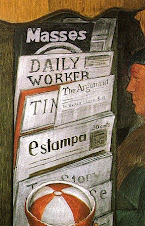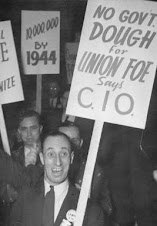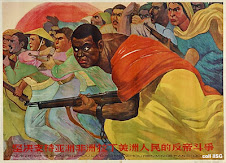By Joyce Chediac
Published May 18, 2011 3:55 PM
Thousands of Palestinian refugees from Lebanon, Syria, the West Bank and Gaza surged across fenced off borders and into Israel on May 15, asserting their right to return home. The unarmed protesters were fired upon by Israeli soldiers, killing 16 and wounding hundreds.
These brave, coordinated, “Return to Palestine” marches by the Palestinian people marked “al Nakba,” the Catastrophe, the anniversary of the expulsion by force and terror of 750,000 Palestinians from their homes by Zionists in 1948, and the establishment of Israel in its place.
Inspired by protests in much of the Arab world, this was the first time in 63 years that Palestinian refugees marked their expulsion by going to the border in the tens of thousands and calling for their right to go home. It electrified the Arab world and showed that, no matter what forces are arrayed against them, the Palestinian people will not abandon their right to return.
Palestinians marching from Jordan were attacked and stopped by Jordanian soldiers before they reached the border. The Egyptian military fired into crowds to repress them after three days of actions in solidarity with Palestine in Egypt, culminating in a protest in front of the Israeli Embassy. Jordan and Egypt are the only Arab countries that have signed a peace treaty with Israel.
Coordinated actions reflect Hamas-Fatah agreement
Speaking from Gaza, Palestinian Prime Minister Ismail Haneyya said that Palestinian and Arab blood spilt during Nakba marches suggests that Nakba is being marked with a new spirit and that the Palestinians have begun to “bury the Nakba” for good. He said that the situation marked the “first application” of the recent Fatah-Hamas reconciliation practiced on the ground, as differences were set aside for the greater national interest.
Palestinian President Mahmoud Abbas of Fatah lauded those Palestinians mowed down as “martyrs” killed by “the Israeli occupation while they were in a demonstration commemorating the Nakba inside the nation.”
No Western governments condemn Israeli killings
The Israeli government responded with deadly force against the unarmed protesters, who certainly posed no physical danger. This bloody response made clear who the terrorists are in this continuing struggle. But neither the U.S. government nor its European allies have issued even one word condemning the murder of Palestinians by Tel Aviv. In fact, while Palestinians mourn their dead, Israeli Prime Minister Benjamin Netanyahu will be greeted by President Barack Obama in Washington on May 20, and Netanyahu has been asked to address a joint session of Congress!
Meanwhile, on May 16 the Israeli and Egyptian navies together opened fire in international waters on a Gaza freedom flotilla ship, the Spirit of Rachel Corrie, carrying plastic sewage pipes to help restore the devastated sewerage system in Gaza. None of the anti-war activists and journalists, from Malaysia, Ireland, India and Canada, were harmed. The vessel is now anchored in Egyptian waters, about 30 nautical miles from Gaza.
Lebanon, Syria, Jordan, Egypt
In Lebanon on May 15, thousands of women and men, young and old, secular and religious, gathered in the mountain-top border town of Maroun al Ras, which has a panoramic view of occupied Palestine. For many it was the first time they saw their country, which previously they had only heard described by their elders.
Soon after speakers began addressing the crowds, thousands headed down the opposite side of the mountain — though it was littered with Israeli landmines — towards the border fence. Calling for their right to return, they climbed and placed Palestinian flags on the fence. Some began throwing stones at soldiers so far off they could barely be seen.
The soldiers opened fire, and 11 people were killed and about 100 wounded. Participating in the action were the Palestinian ambassador to Lebanon, Abdallah Abdallah, and representatives from Hezbollah, and the Future Movement, which is aligned with it.
Four people were killed and four others critically hurt by Israeli gunfire after hundreds of protesters from a Syrian-held part of the Golan breached the fence and entered the part of the Heights annexed by Israel. Syrians and Palestinians broke through the fence from both sides, greeting relatives arbitrarily separated by the border. Israeli troops fired live rounds and tear gas at the protesters.
In Jordan, police intercepted and stopped several thousand Palestinians from marching to the border with Israel, injuring at least 25. “The people want to liberate Palestine,” was one of the slogans the young people chanted earlier near the Israeli Embassy in Amman. “We are ready to die for Jerusalem. The right of return is sacred.” (AFP, May 15)
In Egypt, a huge crowd gathered in support of Palestine on May 13 in Cairo’s Tahrir Square. Many had intentions of traveling to the border crossing with Gaza on May 15, to demand that the blockade of Gaza be broken. The Egyptian government, however, set up checkpoints and closed the bridge and tunnel into the Sinai Peninsula to stop this from happening.
As an alternative, Egyptian and Palestinian protesters gathered for hours at the Egyptian Embassy in Cairo on May 16, waving Palestinian flags and burning an Israeli flag. They demanded the expulsion of the Israeli ambassador and the closing of the embassy. At least 350 pro-Palestinian demonstrators were injured, and over 150 were arrested when Egyptian police and military violently crushed this protest, firing live ammunition, tear gas grenades and rubber bullets at the crowd.
Spirits remained high, however, with youth grabbing the tear gas canisters and throwing them back at the army. Men and women raised a chant that is now well known in Egypt: “We are not afraid! We will not bow down! We have gotten used to bullets!”
A day of mourning and determination
There are now more than 4.8 million Palestinian refugees officially registered with UNRWA, the United Nations Relief and Works Agency for Palestine Refugees in the Near East, throughout the Arab world, including Syria, Lebanon, Jordan, the West Bank and Gaza. Palestinian refugees are the longest-lasting and largest refugee population in the world. They live in limbo, a stateless people denied their human rights both internationally and in the countries where they live. Conditions for Palestinians are by far the worst in Lebanon.
May 16 was declared a day of mourning in all 12 Palestinian camps across Lebanon as families of the 11 people killed prepared to bury their dead.
All work stopped in Lebanon’s southern Palestinian camps to make way for mourners who gathered in their thousands to bid farewell to Imad Abu Shakra, 18; Abdel Rahman Said Sobhi, 20; and Mohammad Abu Shleeh, 28, three of those killed. Similar funerals were held in Al-Bass and Burj Al-Shamali camps near the southern port city of Tyre.
“In Ain el-Helwi, the bodies of Abu Shakra, Sobhi and Shleeh were held up high by procession members, who also carried banners and chanted slogans reflecting their deep longing for their loved Palestine.” The men had “sacrificed their lives for the right to return,” read one banner. “We will fight, we will die, we will return to Palestine,” read another. (Beirut Daily Star, May 16)
Subscribe to:
Post Comments (Atom)










































No comments:
Post a Comment